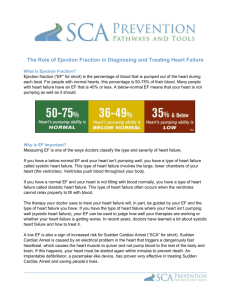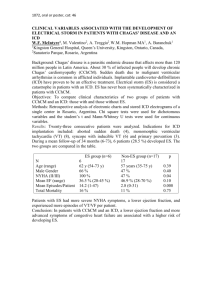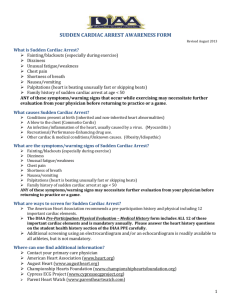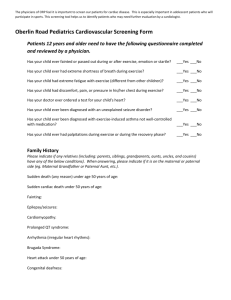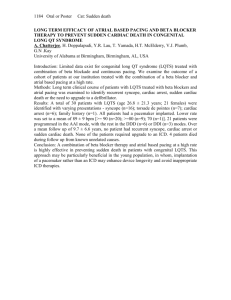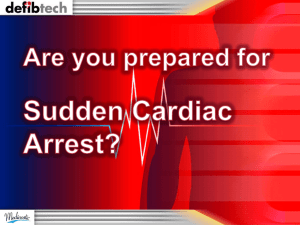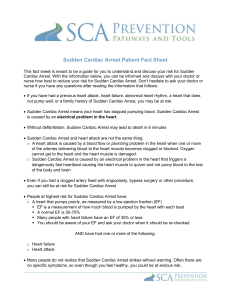Patient Pre ICD SCA FAQs - American Heart Association
advertisement
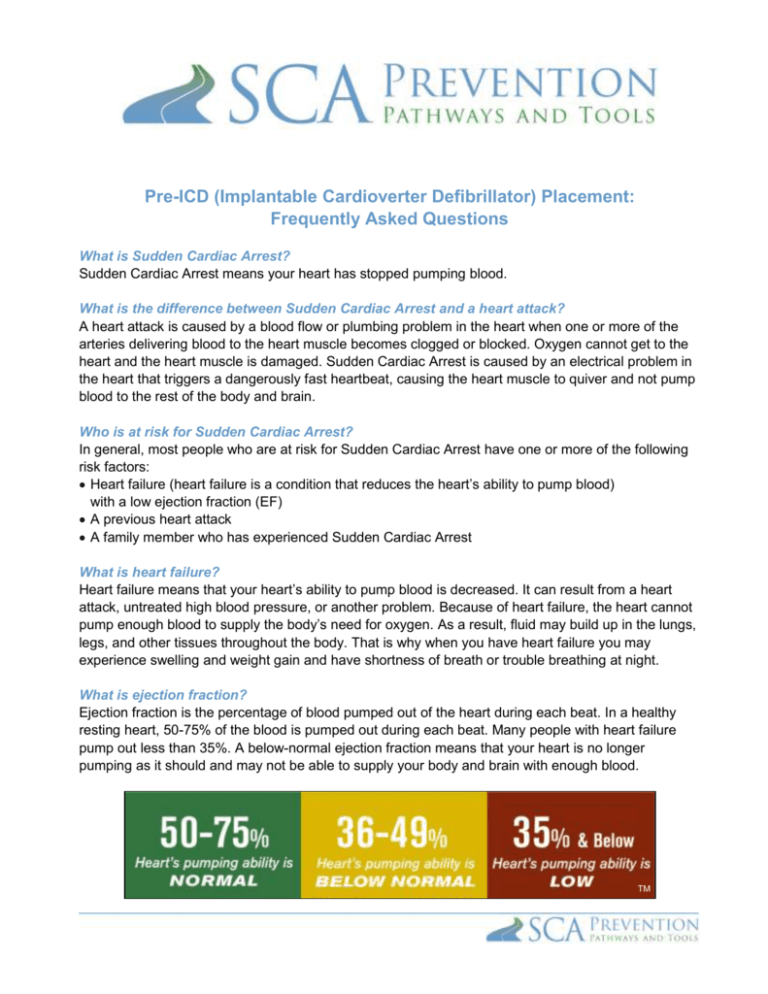
Pre-ICD (Implantable Cardioverter Defibrillator) Placement: Frequently Asked Questions What is Sudden Cardiac Arrest? Sudden Cardiac Arrest means your heart has stopped pumping blood. What is the difference between Sudden Cardiac Arrest and a heart attack? A heart attack is caused by a blood flow or plumbing problem in the heart when one or more of the arteries delivering blood to the heart muscle becomes clogged or blocked. Oxygen cannot get to the heart and the heart muscle is damaged. Sudden Cardiac Arrest is caused by an electrical problem in the heart that triggers a dangerously fast heartbeat, causing the heart muscle to quiver and not pump blood to the rest of the body and brain. Who is at risk for Sudden Cardiac Arrest? In general, most people who are at risk for Sudden Cardiac Arrest have one or more of the following risk factors: Heart failure (heart failure is a condition that reduces the heart’s ability to pump blood) with a low ejection fraction (EF) A previous heart attack A family member who has experienced Sudden Cardiac Arrest What is heart failure? Heart failure means that your heart’s ability to pump blood is decreased. It can result from a heart attack, untreated high blood pressure, or another problem. Because of heart failure, the heart cannot pump enough blood to supply the body’s need for oxygen. As a result, fluid may build up in the lungs, legs, and other tissues throughout the body. That is why when you have heart failure you may experience swelling and weight gain and have shortness of breath or trouble breathing at night. What is ejection fraction? Ejection fraction is the percentage of blood pumped out of the heart during each beat. In a healthy resting heart, 50-75% of the blood is pumped out during each beat. Many people with heart failure pump out less than 35%. A below-normal ejection fraction means that your heart is no longer pumping as it should and may not be able to supply your body and brain with enough blood. TM Why is it important to know my ejection fraction? Your ejection fraction is one of the ways your doctor can diagnose heart failure and identify people who are at risk for Sudden Cardiac Arrest. Recent medical research shows that heart attack survivors and people with heart failure who have an ejection fraction of 35% or below are at higher risk for dangerously fast heart rhythms and Sudden Cardiac Arrest.1 How is ejection fraction measured? A simple and painless test called an echocardiogram, or “echo,” is generally used to learn the ejection fraction. The test, which uses ultrasound to measure how well your heart is pumping, can often be performed in your doctor’s office. There are other imaging tests that can be used to measure your ejection fraction. How is Sudden Cardiac Arrest treated? The only effective way to treat Sudden Cardiac Arrest is defibrillation. Defibrillating means giving the heart an electric shock in a controlled manner to restore a normal heartbeat. This treatment is mainly given in two ways: by an automated external defibrillator (AED), or by an implantable cardioverter defibrillator (ICD). What is an automated external defibrillator (AED)? AEDs are portable devices that measure the electrical activity of the heart and deliver defibrillation therapy if a fatal heart rhythm is detected. Most Emergency Response Teams carry and use AEDs. Thanks to recent studies2,3 showing their lifesaving role, AEDs are being placed in public gathering spots, such as government centers, airports, casinos, malls, stadiums, schools, and office buildings. AEDs do not work by themselves and need to be operated by someone else. You cannot use the AED on yourself. Here is a picture of an AED: What can be done to reduce my risk for Sudden Cardiac Arrest? Defibrillation within 6 minutes is critical to survive Sudden Cardiac Arrest. An ICD is the most effective way to treat Sudden Cardiac Arrest (see next page). It is always there, monitoring your heart rate and administering treatment if needed. What is an ICD? An ICD is a pacemaker-like device that has been available since the mid-1980s. It is small – about the size of a pager – and is implanted under the skin in your upper chest. The battery and computer circuits needed to correct your heart rhythm are contained in the device. Thin insulated wires, called leads, connect the implantable defibrillator to your heart. If the device detects a problem with your heart rhythm, it will use electrical signals to correct your heart rate. Most implantable defibrillators last 5 to 7 years before they need to be replaced. An implantable defibrillator is the most effective way to treat Sudden Cardiac Arrest. It is programmable and will deliver just the right amount of therapy for your particular heart problem. Once it is implanted, an ICD will work by itself, but does require follow-up checks. Here is a diagram of an ICD: How does an implantable defibrillator work? Depending on how it is programmed, an implantable defibrillator can first use small, painless electrical signals to correct your heart rate. If these do not work, a stronger shock is delivered. People describe the shock as surprising and uncomfortable, sometimes even painful, but the feeling passes quickly. Quite often, it is over before you are fully aware of what happened. The good news is that your implantable defibrillator is continuously there monitoring and protecting you, 24 hours a day. What are the risks and precautions? Generally, use of ICDs is considered safe and highly effective. However, there are potential risks associated with any implantable device system. Risks include, but are not limited to, infection at the surgical site and/or sensitivity to the device material, failure to deliver therapy when it is needed, or receiving extra therapy when it is not needed. After receiving an ICD, you will have limitations with magnetic and electromagnetic radiation and electric or gas powered appliances and tools with which you are allowed to be in contact. Although many patients benefit from the use of these products, results may vary. Please note that there are other important risks and precautions that you will need to review with your physician. Your physician should review all risks and benefits with you. Will I be able to drive? Most people with an ICD are able to resume driving depending on their doctor’s advice and the laws and insurance regulations of their state. Will I be able to travel? Most people with an ICD can travel without taking special precautions, but you should discuss this with your doctor. Most patients can travel without problems soon after their ICD implantation. Will I have a problem with airport security? Airport security systems may detect the metal of your ICD and you may be asked to undergo an additional search. Patients receiving ICDs are given a device identification card, which can be presented at airport security if needed. You can also request a hand search. You should request that any handheld screening devices be kept away from your ICD, since they have the potential to trigger defibrillation therapy. What happens during the implant procedure? The following is intended as a general overview. The implant procedure is typically quick, low risk, and usually done under local anesthesia. It does not require open-heart surgery, and most people typically stay overnight. Patients are normally sedated throughout the procedure and should not feel any pain. Your doctor will make a small incision in the upper chest and guide the leads through a vein and into your heart. Your doctor will connect the leads to the ICD and program the device. Then the ICD will be inserted beneath the skin and the incision in your chest will be closed. Your physician will test the ICD to ensure that it is working properly. Your experience may differ, so please talk to your doctor for specifics regarding your implant. What happens following the procedure? Following surgery, you will stay in the hospital overnight and go home the next day. You will see a bump under your skin where your device is located and the area may be tender. Generally, you should limit arm movement on the side of your ICD for about 2 to 6 weeks. Your doctor will provide you with more specific care instructions, but you can expect to gradually return to your everyday activities shortly after the procedure. If you have any questions, please ask your doctor or nurse. What about follow-up after the procedure? After the implant, the doctor who implanted your defibrillator will work with the doctor who manages your heart disease. You will still need to take your medication as prescribed and have your ICD checked from time to time. Ask your doctor or nurse about your schedule for follow-up visits with each of your physicians. It is important to keep your appointments with each of your doctors and to follow the recommended daily care instructions to ensure the best possible results. Depending on what type of device you have, you might be able to use a monitoring service that allows you to transfer information from your device to your clinic over a telephone line. This service may reduce the number of clinic visits you need. Your device helps you only when it is functioning properly. It is important to receive regular follow-up care by your electrophysiologist and the doctor or nurse treating your heart failure. Safety Information Additional Device Information An implantable cardioverter defibrillator (ICD) system delivers therapies to treat patients with heart rhythm disorders or who are at significant risk of developing heart rhythm disorders. An ICD is placed inside your body and works automatically. Risks associated with an ICD system implant include, but are not limited to, infection at the surgical site and/or sensitivity to the device material, failure to deliver therapy when it is needed, or receiving extra therapy when it is not needed. After receiving an ICD system, you will have limitations with magnetic and electromagnetic radiation, electric or gas powered appliances, and tools with which you are allowed to be in contact. Treatment with an ICD system is prescribed by your physician. This treatment is not for everyone. Please talk to your doctor to see if it is right for you. Your physician should discuss all potential benefits and risks with you. Although many patients benefit from the use of this treatment, results may vary. References 1 European Heart Rhythm Association; Heart Rhythm Society; Zipes DP, et al. ACC/AHA/ESC 2006 guidelines for management of patients with ventricular arrhythmias and the prevention of sudden cardiac death: a report of the American College of Cardiology/American Heart Association Task Force and the European Society of Cardiology Committee for Practice Guidelines (Writing Committee to Develop Guidelines for Management of Patients With Ventricular Arrhythmias and the Prevention of Sudden Cardiac Death). J Am Coll Cardiol. September 5, 2006;48(5):e247-346. 2 Bardy GH, Lee KL, Mark DB, et al; Sudden Cardiac Death in Heart Failure Trial Investigators. Amiodarone or an implantable cardioverter-defibrillator for congestive heart failure. N Engl J Med. January 20, 2005;352(3):225-237. 3 Moss AJ, Zareba W, Hall WJ, et al; Multicenter Automatic Defibrillator Implantation Trial II Investigators. Prophylactic implantation of a defibrillator in patients with myocardial infarction and reduced ejection fraction. N Engl J Med. March 21, 2002;346(12):877-883. Developed by the SCA Prevention Medical Advisory Team. This material is intended to be educational. It is not intended to replace the information provided to you by your healthcare providers and may not be directly applicable for your individual clinical circumstance. Please refer to the manufacturers’ prescribing information and/or instructions for use for the indications, contraindications, warnings, and precautions associated with the medications and devices referenced in these materials. Sponsored by Medtronic, Inc. May 2007 UC200705525 EN
